Having A Drink With Ernst Havemann
Saturday, January 13, 2007
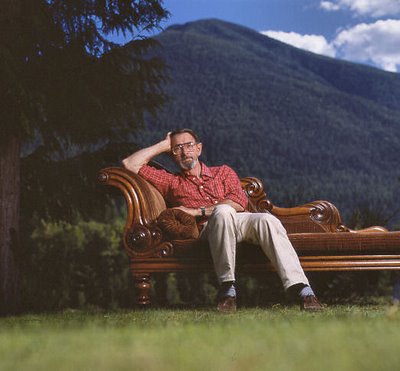 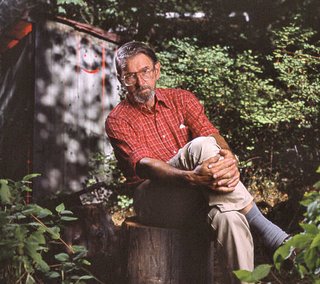 This blog and the next will pursue the theme of the previous one on drink. In 1987 good magazines published fiction. Saturday Night published fiction. For their April issue they dispatched me to Nelson to photograph an author I did not know anything about. He was a mining engineer who had been born in a farm in Zululand, South Africa in 1918. His first language was Zulu. After her retired he began to write. He had come to be known in Canada because he had won the CBC Fiction Prize four times. I arrived in my rented car from the airport, before noon and it almost became my undoing. The affable man told me I was going to stay for lunch and offered me a cocktail. During lunch we ate in a porch that overlooked Kootney Lake. The lake was right there and Havemann told me he liked to fish in his back yard. Lunch include several courses which were served with, "... this special white wine," and "...this superb red." Dessert came with port and and coffee was served with brandy and cigars. I was drunk. I photographed Havemann by his "pit privy". I loved how he pronounced it with a nasal twang. Then we carried the antique sofa outside and took his picture. He looked like a writer of the 19th century. When he suggested we have tea I was relieved. The tea would help me sober up. To my horror cold roast beef and egg sandwiches came with beer. There was no tea in sight. 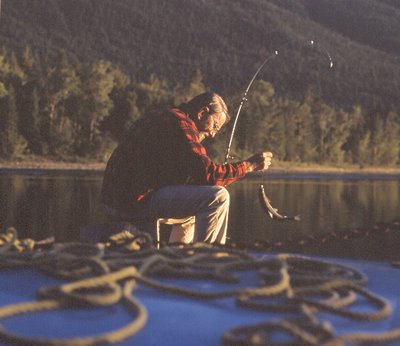 By the time I photographed Havemann pulling a fish from the lake (he had offered to do it with a confidence I had never seen in any other fishermen) I was having a problem setting up lights and moving around. I managed to finish. Havemann said, "Alex I think you should stay for dinner and fly out tomorrow." I thought of pre-dinner drinks, dinner drinks, dessert drinks and... so I politely declined and I somehow made it to the airport in one piece. As soon as I got home I purchased Havemenann's Bloodsong - And Other Stories of South Africa. It is one of my favourite books of short stories. Oddly, when Saturday Night published one of the stories, Tom and Beauty, they edited out the first two paragraphs. Here they are: We didn't have videos and peace movements in those days, so what we talked about where things like who made God, and should you tell your father if your mother was cheating on him.
Arabelle Jones's mother cheated when she went to dances, but Arabelle didn't tell her father: it would just make him more downtrodden. He was such a milktoast, he wouldn't do anything except perhaps desert her and her mother, and Arabelle would miss him. Mr Jones was rich.
The Rubáiyát & A Rubaiyyat - On Gin
Friday, January 12, 2007
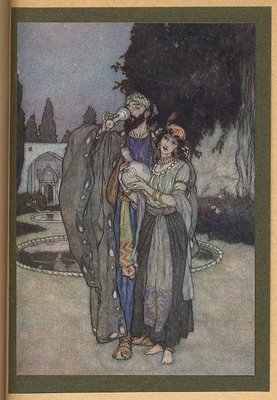 One of my mother's treasures was not a first edition of Omar Khayyám's Rubáiyát rendered into English by Edward Fitzgerald. She would have never been able to afford one. She had (and I inherited it) an early edition that incorporated Fitzgerald's first edition and his revised second edition. Noted illustrator Edmund Dulac did the fine illustrations which are pasted on to the this Hodder and Stoughton edition. My father had a fondness for gin. There were countless nights where I heard him promise my mother that he was going to stop. There was a particular quatrain (as the verses in the Rubáiyát are called), quatrain LVII of the first edition, that hit a chord with my mother. Perhaps she read it out loud to my father. I don't know. 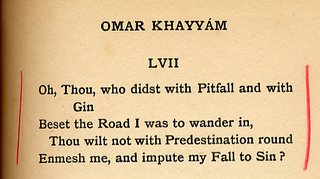 I do know that the page has two bold red pencil marks on either side. My mother died in 1972 and in 1973 I discovered a Penguin edition of the Rubaiyyat (note that the accents are now gone) that was listed as: A new translation with critical comments by Robert Graves and Omar Ali-Shaw (a noted Sufi poet and classical Persian scholar). It seems that my mother's beloved book had been a "transmogrification" (Fitzgerald's own word) of a 15th century Oxford manuscript. It was not not the earliest version of the famous Sufi work. An authorative 12-century version had been available to Sufic students in Afghanistan shortly after Khayaam's (note new spelling) death more that 830 years ago. I was startled to read side by side comparisons and I was upset to find out that Fitzgerald had even used Arab/English dictionaries in a straight literary meaning of the word fashion for his work. The real meanings of the quatrains in Graves's translation, while not having the aura of romance, had in some cases a completely different meaning. I wonder if this "true" edition might have pursuaded my father to quit his gin. My mother's marked quatrain LVII reads as follows in the Graves translation: I shall possess myself of a great goblet
With pipes of wine for its replenishment,
Annulling former ties to Faith and Reason
By marriage with this daughter of the Vine.Accurate or not my father might have replied from Fitzgerald's first edition, quatrain LXXI: And much as Wine has play'd the Infidel,
And robb'd me of my Robe of Honour-
well,
I often wonder what the Vinters buy
One half so precious as the Goods they
sell.
Gloria Macarenko & Cecilia Walters vs Shelagh Rogers's Mother
Thursday, January 11, 2007
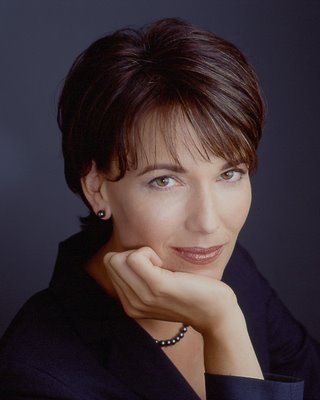
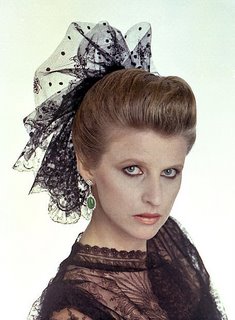
Be forewarned, if you read further, that I know little about television. My wife Rosemary and I limit ourselves to the Turner Classics Movies channel at 6:30 pm on Tuesdays for the Star of the Month series. This month we are thoroughly enjoying the films of Jean Arthur. While watching her it got me to thinking about CBC TV's Gloria Macarenko. There might not be any obvious connection unless you ever listened to Bill Richardson's fine CBC Radio program Bunny Watson, which like all good things had to go away. In that program Richardson showed how everything can be connected through association if you look hard enough. Jean Arthur was a forceful heroine who apparently in real life was absolutely terrified (unlike Katherine Hepburn as Bunny Watson) of appearing on a film set and fought nausea and worse. Yet she was so natural and wonderful.
There are forceful women in our media, particularly on CBC Radio, my radio station of choice. Mary Lou Finlay was one of my faves and Ana Maria Tramonti is growing on me. The most forceful of them all was Shelagh Rogers's ( Sounds Like Canada) mother who appeared on Rogers's show a few times. Her voice was stronger and her laugh louder than her daughter's. And of course there is the inimitable and wonderful Barbara Budd of As It Happens. Budd could make my granddaughter Lauren, 4, finish her Chicken a la Barbara (Lauren loathes it unless we call it paprika chicken) without any needed persuasion. On CBC radio, the women are women that are no-nonsense. They are intelligent. They matter to me. I would love to sit down for tea with any of them. I like them, I love them. But for TV, we Canadians ( at least here in Vancouver) choose a different kind of woman. She is not so forceful, she is more sensitive and there is some sort of Jean Arthur fragility and an almost hidden sadness that is masked by what seems to be an effortless performance. Two such women come to mind.
At 8:30 every weekday morning I get to hear Cecilia Walters (no speech impediment, no lisp, and a clean and crisp delivery) whom I met in the late 80s. She came to my studio for a photograph that accompanied a Vancouver Magazine profile. The magazine hired Sonny of Broadway to do her hair. I had my best makeup person and Tony Cavelti, escorted by an armed guard, brought the lovely emerald and diamonds ear rings you see in the picture here, above right. Perhaps we Canadians weren't as sophisticated then to appreciate a low key, sensitive (and intelligent) female TV news anchor and we would have settled for someone like CNN's Paula Zahn. The little I have seen of Paula Zahn reminds me of that scene in Butterfield 8 where Elizabeth Taylor drills and then grinds her stiletto high heel on Lawrence Harvey's shoe. Paula Zahn would probably have made it even more painful for Harvey.
Since I prefer to read my news in my daily print edition of the New York Times at 6:30 am, I have seen little of Gloria Macarenko on TV. But I have seen enough to be charmed and drawn in. For news of Vancouver I listen to CBC radio. I have had the good fortune of having Macarenko in my studio a couple of times. I don't think any man in my place could feel any different than I felt when this woman looked into my lens and straight (it would seem) into my soul. Then she spoke to me in her perfect Castilian. Had I been a few years younger (this happened in 1999) I would have challenged her husband to a duel at 6am (with time to rush home to read the NY Times) in the back alley to Holy Rosary Cathedral. I subsequently met the charming Mr Enrique Manchon, who is a terrific photographer, socially at art openings and desisted from striking him with my glove.
Recently I asked Macarenko if I could bring my granddaughter Rebecca to watch her during her CBC News: Canada Now broadcast. We did (escorted and given a tour of the place by cameraman Michael Varga) and as I watched this woman, I realized why it is that I love Canada and I why I especially like to live in Vancouver. We are now sophisticated enough and un-American enough to appreciate what we could not, back then with Cecilia Walters. Macarenko is the perfect TV news anchor. I wonder if the CBC knows? Rebecca was charmed by Macarenko and the next day nobody in school would believe that she had actually seen her live and talked to her!
Macarenko has been doing her own makeup for years (oh! the scandal) because the CBC does not have the budget for a makeup person. I am sure that if Jennifer Mather, in her new CBC TV show, does not get her makeup, there will be holes in her producer's shoes.
Gloria Macarenko
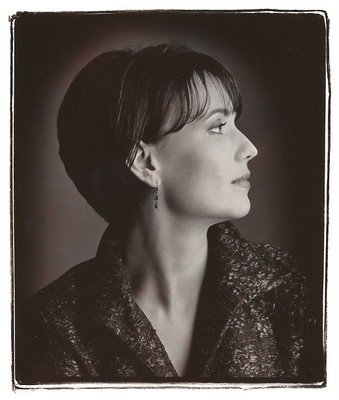
Martin Beaver's 1729 Guarneri del Gesù
Wednesday, January 10, 2007
 In May 1997, the University of Western Ontario announced the sale of three violins - a 1689 Baumgartner Stradivarius, a 1702 Lyall Stradivarius and a 1729 Guarneri del Gesù to an American purchaser. The buyer requested anonymity and then loaned all three instruments to the Canada Council Instrument Bank for a two year period. In 1997 Canadian volinist, Martin Beaver (31) was the winner of a competition, and as a prize he won the two-year loan of the Guarnerius. I could post here sites comparing the Stradivarius (the Rolls Royce of violins) to the Guarnerius (the Bentley). The fact is that few may know that there were several Guarneri from Cremona who made violins, and that one, Bartolomeo Guiseppe Guarneri (1698-1744) is the most famous of the family. His violins always incorporated a label that had the Greek characters I.H.S. (iota - eta - sigma or iesu) and a Roman cross.  Guiseppe Guarneri has been known since as Guarneri del Gesù. It is only recently that the Guarneri violins have stopped being Bentleys. Many experts and musicians, in spite of the fact that some of the Guarneri violins are bigger, almost fattish, and not too pretty, now believe that they are superior to the Stradivarius. I have heard Corey Cerovsek's Stradivarius in concert and he even brought it to my studio but I didn't dare ask him to play it. Beaver (left) did play his Guarnerius and he commented on the wonderful acoustics of my studio. I wish I had a musician's memory for this sort of thing so I could compare. And I have had a few opportunities to compare violins. Violinists Marc Destrubé and Paul Luchkow brought and played their instruments in my studio. Mark Fewer, concertmaster of the Vancouver Symphony Orchestra played his electric violin, and Karen Gerbrecht, and Cam Wilson, and Rebecca Whittling and Robin Braun, their violins and Laura Kramer her baroque cello, and Colin MacDonald his soprano saxophone, and Peggy Lee her modern cello, Glenys Webster played her viola, Patricia Hutter her string bass and.......my studio is on a third floor with no elevator. I believe I will never hear a piano. A harpsichord, perhaps? Next time Corey Cerovsek comes to town I will invite him for tea to my studio and ask him to bring along his violin. Addendum by Paul Luchkow Hi Alex, My friend Michael Jarvis has a square Chickering parlour piano that is easily moveable... You may get a piano yet. And, my current 'modern' violin is a true modern instrument--It was made by a couple of luthiers in NYC. It is, however, a copy of the "Alard" Guarneri del Gesu. (1742) Paul Addendum by CBC producer and broadcaster Michael Juk Hi Alex, I just had lunch with Mark Fewer and am at my desk editing a CD of music by Oskar Maorawetz performed by Jasper Wood so the violin theme seems to be very strong at the moment. That del Gesu was a beauty. I remember being struck by how yellow the colour was. I think the finish had just been redone at that time. Martin told me the instrument required quite a bit of strength to play. Del Gesus tend to have a bigger voice than strads and are often used for concertos. Perlman has a Strad for chamber music and a del Gesu for concertos. MJ Martin BeaverCorey Cerovsek
Johnny Thunders From The Heart
Monday, January 08, 2007
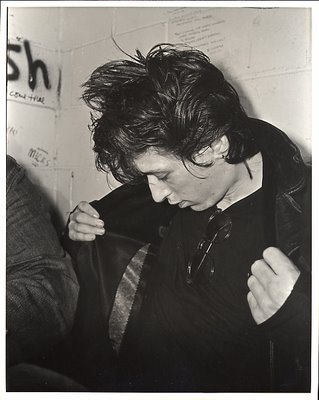 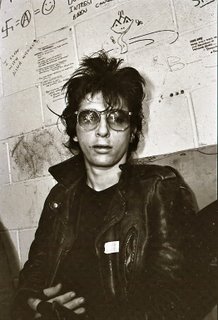 In 1981 I had the scary fortune of being able to be in the back room of Gary Taylor's Rock Room with Johnny Thunders ex guitarist (then) of the New York Dolls. His concerts began late and would sometimes finish early, when he would pass out on stage. I think that the people who went to see Thunders were divided into two groups. One group was there to see if the combination of Courvoisier and heroin would finally kill the man then and there. Others like my friend Les Wiseman and I were there to hear him play the guitar. In a 30 minute set there might be 5 or 10 minutes of passionate and virtuoso guitar that had no equal anywhere. Taking shots of Thunders put me in a spot as I had always tried to make people look as good as I could. He looked hopeless. While doing my shots, Thunders told me it was only fair that he take my picture. This he did. 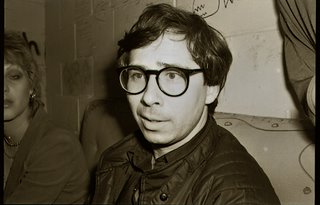 A couple of years later Les Wiseman and I went to New York and we had the good fortune of seeing Thunders again. He was carried off stage when he passed out. We patiently waited almost an hour. He came back and gave us what so few musicians seem to be able to do now. He gave us music from the heart. As did our very own Art Bergmann, but that's another story. Gary Taylor's
Wood & Wong - Two Compliments - One Underhanded
While there are many pleasures in taking photographs for publication, one of the decided downers is that those photographs appear and are then swallowed into oblivion. It is only if you have any self-confidence to realize you are any good that you can survive the silence that invariably follows. But there are some rare exceptions. Here are two.
I photographed (1997) then video artist Paul Wong for Vancouver Magazine. A year later, since I was an Outreach instructor at Emily Carr I was invited to participate in a faculty art show. One of the pictures I exhibited was a b+w version of this one of Paul Wong. When he posed for me he told me, "I really want to look Chinese."
In 1999 I photographed photographic artist Kelly Wood for a review of her show Continuous Garbage Project for the Globe & Mail. In the photo here she is holding the last bag (March 14, 1999) of her March 15, 1988 to March 14, 1999 project. When I arrived at the Catriona Jeffries Gallery on Granville Street, Wood smiled at me and told me she was honoured to have a real (that's the word she used) photographer photograph her.
As for Paul Wong, his photograph disappeared the day after the opening of the show at Emily Carr. I have my suspicions.
Chimping Snapshots
Sunday, January 07, 2007
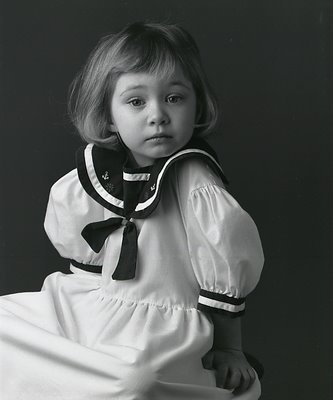
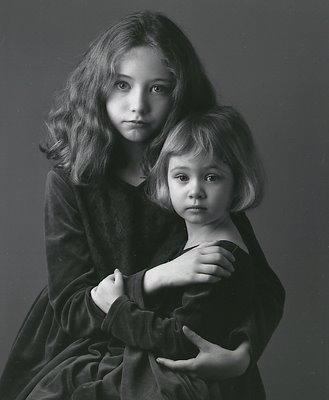
The true snapshot has disappeared from most photographers' grasp. When box cameras and 620 roll film ruled the world (the little Leica's were tiny "gadgets" that snapped at the heals of the lumbering box cameras) friends would tell you, "I hope they come out," or "Good luck." Snapshots were photographs that "turned out" when most of them didn't. We appreciated snapshots because we were lucky to get them, to have them. Can a digital camera take snapshots? Can an image that is captured (to parlay the modern lingo) be a snapshot when we can see it instantly and we can delete it and or re-take it?
I have wanted to photograph my grandaughters in the controlled lighting environment of my studio for almost a year. The problem was trying to find a friendly makeup artist to do the honours since my eldest daughter was playing vague and uncommitted. A couple of makeup artists I know either had a too busy schedule or were burned out. Finally my wife lured my Ale in a "if we do this for your you will do this for us" exchange. That was yesterday.
We had several dresses for Lauren (4) but besides Rebecca's former sailor dress and Lauren's wine coloured Christmas dress that was the end of it. She refused to cooperate. Rebecca at 9 was even more difficult. She stamped her feet, looked at my camera cross-eyed and threatened to cry which would have run all of Ale's expertly applied mascara.
Here are some of the results. The colour picture is a scanned Polaroid, of Rebecca in her Halloween costume. It is the closest I have ever gotten to "chimping".
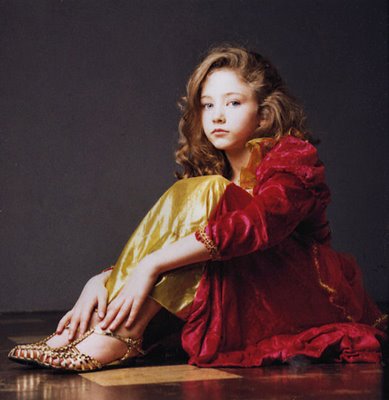
To chimp is to look at the LCD image in the back of digital camera and where you make that instant decision (or not) to scramble a real live person's photons into a region beyond William Gibson's cyberspace. Perhaps they go to that hallowed place were all the snapshots we ever took, that never turned out, still exist as latent images that could have been.
|
























